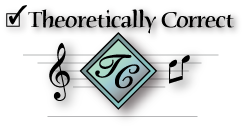MIDI numbering, the Helmholtz Pitch Notation System,
and other octave numbering conventions
used in music and music notation
The following charts show four common pitch and octave numbering systems:
• MIDI numbering • Octave Numbering (there are two of these), and the
• Helmholtz Pitch Numbering (aka the Helmholtz Pitch Notation System)
In each example below the pitch range is identical, however the notation is displayed on different clefs.
Example 1: the notation is shown on a grand staff
Example 2: the same material shown in treble clef
Example 3: the same material shown in bass clef
Example 4: lastly, the material is shown on a staff that changes from bass clef to treble clef.
NOTE: The underlining merely delineates an octave and is present for no other reason.
Octaves are shown alternately, underlined, and then not underlined.

1: MIDI numbering
2: Octave Numbering (Japanese, Yamaha, Encore)
3: Octave Numbering (scientific, MusicXML, and others)
4: Helmholtz Pitch Numbering System*
There are other ways of identifying pitches, such as Hertz (cycles per second). However, due to the number of temperaments and tuning systems there is no universal agreement on the Hertz/frequency of musical pitches. Regarding octaves, it's understood that an octave above a given pitch is approximately double its frequency, and an octave below is approximately half its frequency. So while the concept of Hertz-doubling or Hertz-halving is informative, and reveals something significant about the nature of sound, it implies a precision which is not useful for octave numbering ...and results in a "sea" of frequency numbers which are not easily remembered or recognized. In contrast, the octave numbering systems listed above are useful precisely because they are not intended to be "Hertz precise. "
The Helmholtz Pitch Numbering system uses punctuation marks to differentiate octaves. In the variation used on this page (which is most commonly used in the U.S.) graduating apostrophes indicate octaves on the upper half of the piano keyboard.
The octave starting at Middle C uses a single apostrophe ('), the next octave uses a double apostrophe (''), the next uses a triple apostrophe ('''), etc.
Octaves below Helmholtz C D E (two octaves below Middle C) employ graduating commas instead of apostrophes. For example, single commas indicate the third octave below Middle C; double commas indicate the octave below that.
Note: The original Helmholtz system used small lettering instead of punctuation. A superscript i indicated the first upper octave, followed by a superscript ii, a superscript iii, etc. Subscripted letters designated the lower octaves.



*Helmholtz Pitch Notation may go by different names, including Helmholtz Pitch Numbering.
Helmholtz is one of the octave numbering systems widely used in music.
Read about Helmholtz Pitch Notation here ... on wikipedia
Here's an other source on Helmholtz notation and other octave numbering systems
